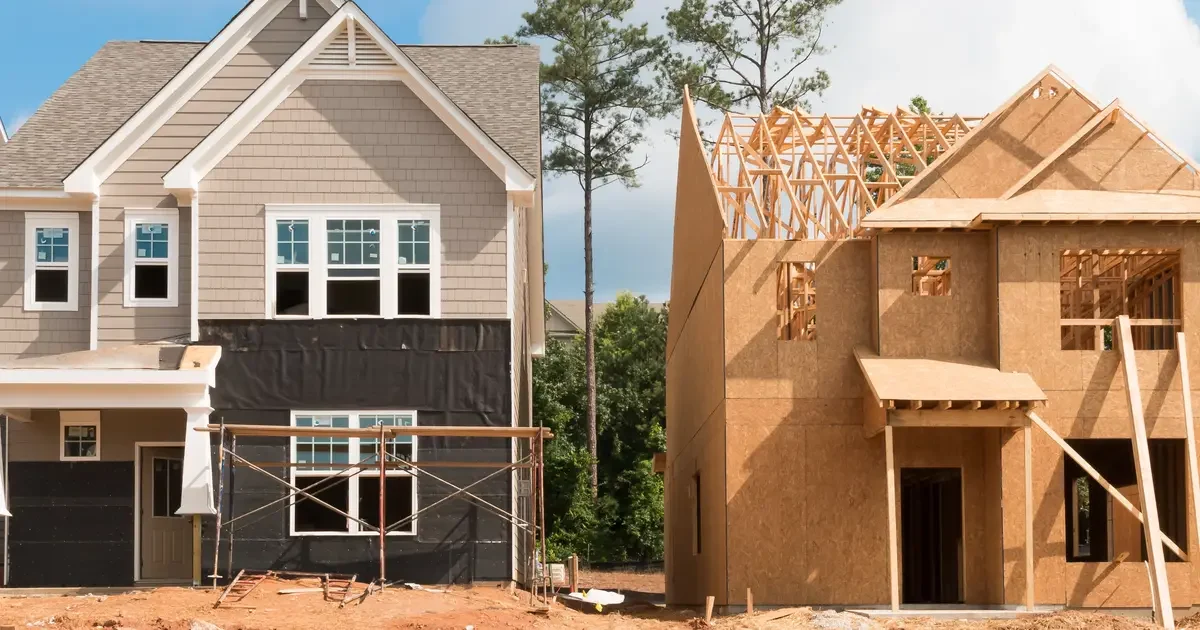When beginning the homebuying process, one of the decisions you may come across is whether to purchase a newly constructed home or an existing property.
New construction homes often feature modern designs, energy-efficient systems, and the appeal of being move-in ready. However, existing homes may offer significant advantages, particularly in terms of affordability, location, and character.
By carefully evaluating the full range of costs, benefits, and potential trade-offs associated with each option, you can make a well-informed decision that aligns with your financial situation and long-term homeownership goals.
The Appeal of New Construction
There’s something exciting about being the first to live in a home. New construction homes offer modern layouts, energy-efficient systems, and minimal immediate repairs or renovations. Some of the key financial benefits of buying new construction include:
Builder Incentives
Builders sometimes offer financial incentives such as closing cost assistance, rate buydowns, or special financing advantages. These programs can reduce your upfront costs and make it easier to secure more favorable loan terms.
Simpler Offer Process
Since builders typically sell multiple homes, buyers may face less competition and a more straightforward offer and acceptance process compared to bidding on an existing home in a competitive resale market.
Lower Maintenance Costs
New homes are built to current building codes and often include warranties on major systems and appliances. That means fewer surprise repairs in the first few years and the ability to better forecast budgeting during the early years of homeownership.
Energy Efficiency
Newer homes tend to have better insulation, windows, and HVAC systems, which can lead to lower monthly utility bills. This may free up more room in your budget to comfortably afford your mortgage and other homeownership expenses.
Greater Customization
Many builders allow buyers to personalize features such as flooring, cabinetry, fixtures, and paint colors, helping you create a home that reflects your style without the need for future renovations.
It’s important to note that while these benefits may be attractive, these benefits can often come at a higher upfront cost. On average, new construction homes have higher list prices than comparable existing homes. Plus, depending on the development, you may also need to factor in Homeowners Association (HOA) dues or special assessments for community maintenance.
The Affordability of Existing Homes
Existing homes can offer significant financial advantages for budget-conscious buyers, especially when it comes to lending and mortgage options.
Here’s why an existing home might be the better fit:
Lower Purchase Price
Existing homes typically cost less per square foot than new construction, which can mean a smaller loan amount, lower monthly mortgage payments, and potentially easier qualification for financing.
Established Neighborhoods
Older homes are often located in well-developed communities with mature landscaping, established schools, parks, and other amenities. Homes in desirable, stable neighborhoods may also retain or grow in value over time, helping you build equity faster.
Room for Negotiation
Buyers often have more flexibility to negotiate the purchase price, request seller-paid closing costs, or ask for credits toward repairs. These concessions can lower your out-of-pocket expenses and reduce the amount you need to borrow.
While purchasing an existing home can save you money upfront and offer lending advantages, it’s important to budget for potential renovations, maintenance, and upgrades. Older systems—such as plumbing, roofing, or electrical—may require attention sooner than those in a new build, which could impact your long-term homeownership costs.
Other Financial Factors to Consider
Beyond the initial price tag, other factors impact the overall affordability of new construction vs. existing homes:
Customization Costs
New builds often come with a base price, but adding custom features or upgrades—like quartz countertops, premium flooring, or landscaping—can quickly drive up the total cost.
Insurance Rates
Homeowners insurance for a new home may be less expensive because of the reduced risk of issues, while older homes sometimes cost more to insure due to aging infrastructure.
Property Taxes
New homes are typically assessed at the current market rate, meaning property taxes may be higher. Existing homes may have lower assessments, although this can change after a sale.
Immediate Move-In Costs
Existing homes are often ready for move-in. New construction may require you to purchase essentials like window coverings, appliances, or fencing, adding to your out-of-pocket costs upfront.
Lending Considerations for New Construction vs. Existing Homes
When it comes to financing, both new construction and existing homes offer different advantages, depending on your situation and the loan options you’re considering. Here’s why financing an existing home might be easier:
More Loan Flexibility
Existing homes often qualify for a wider range of loan programs, including government-backed options like FHA and VA loans, which may have lower down payment requirements and more lenient credit criteria. While new homes often also qualify.
Easier Qualification
Because existing homes are move-in ready and have established infrastructure, they tend to meet the necessary standards for loan approval more easily. This can streamline the approval process and potentially save you time and effort.
Potential for Lower Rates
Existing homes may qualify for lower interest rates in certain loan programs due to their stable value and condition, which can lead to long-term savings on your mortgage payments.
While an existing home offers financing benefits, new construction homes can also be financed with the right loan options. You may just need to meet additional criteria, like providing builder warranties or scheduling extra inspections, which could affect the approval timeline. Understanding these nuances helps you make a more informed decision about which home to buy—and how to finance it effectively.
Loan Options for New Construction Homes: What You Need to Know
Newly built homes can generally qualify for FHA, VA, and USDA loans as long as they meet the specific program requirements. But there are a few key differences to note:
FHA Loans
New construction must meet stricter appraisal and inspection standards, and builders often have to provide a warranty. The home must be completed before the loan closes (unless it’s a construction-to-permanent loan).
VA Loans
VA loans can be used for new construction, but the process is more complex. The builder must be VA-approved, and there are additional inspections during the building process. Most buyers use VA loans for completed new homes rather than for homes still under construction.
USDA Loans
New construction can qualify, but USDA has very specific requirements about who builds the home (must be a licensed contractor) and how inspections are handled. Again, most USDA loans are used for existing homes or completed new builds in eligible rural areas.
In practice, existing homes often make it easier to use these loan types because the homes are move-in ready and the paperwork is more straightforward. Builders sometimes prefer buyers using conventional loans to avoid extra steps, though it’s not a hard rule.
Which Option Is Right for You?
Choosing between a new construction home and an existing home often comes down to your personal financial situation, lifestyle preferences, and willingness to take on potential maintenance or upgrade projects.
You may want to lean toward new construction if:
- You prefer a turnkey home with minimal immediate maintenance needs.
- You value modern design, energy efficiency, and the ability to personalize your home.
- You are comfortable potentially paying a premium for newness and builder warranties.
You might find an existing home is a better fit if:
- You want to maximize affordability and potentially get more home for your budget.
- You like the charm and character of older properties.
- You’re willing to invest time and resources into renovations or upgrades over time.
Affordability is about more than just the sale price including ongoing costs, future investments, and how the home fits into your long-term financial goals. Both new construction and existing homes offer unique advantages, and the best choice will depend on your budget, lifestyle, and plans for the future.
At Mutual of Omaha Mortgage, we’re here to help you navigate every step of the homebuying process, from exploring your loan options to helping you determine how much home you can truly afford. Whether you’re leaning toward a brand-new build or a charming existing home, our team is ready to support your journey to homeownership.











